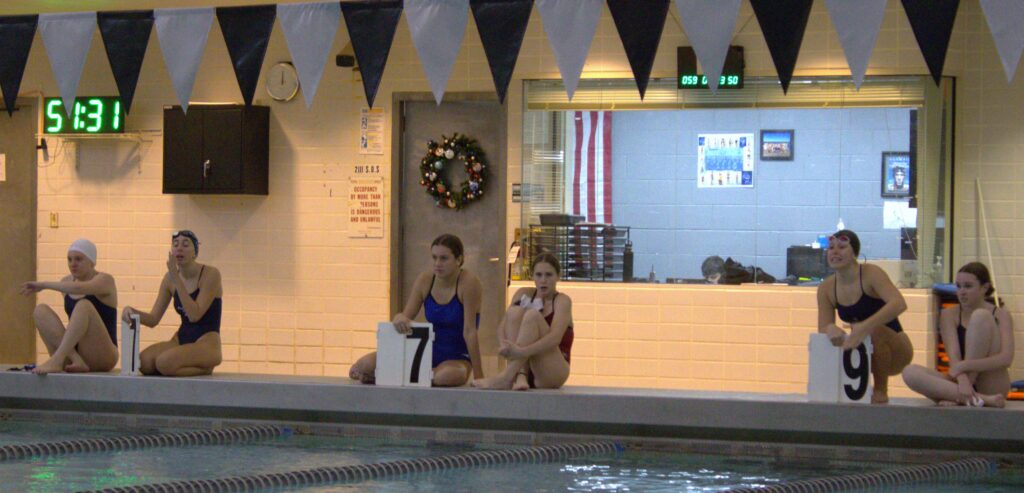By Posted by
Published:Spotlight on swimming: A sport that gets lost in the shuffle
For a sport contested in the water, swimming continues to fly under the radar when it comes to recognition among high school athletics

A mini boom box nestled up to a microphone on the scorer’s table at the College of Staten Island’s Sports & Recreation Center swimming pool, and rap music filled the cavernous space, triggering a combination of jumps and dance moves from the giddy St. Joseph by-the-Sea girls’ swim team.
On the level above, about two dozen or so fans — almost exclusively, family members — were scattered in the balcony seating area, waiting for the start of the Lady Vikings’ last home meet of the regular season against Brooklyn’s Fontbonne Hall Academy.
Back downstairs, several female and male collegians — from last season’s Sea swim teams — used their winter break to visit and pay homage to the squad’s only two seniors, Samantha Carroll and Kylie Feeney, both of whom were encouraged to walk around the pool deck with some of the goodies their teammates had bought them: blue Santa hats, sunglasses, special sashes, bouquets of flowers and gift bags. It was all set to the renowned graduation march “Pomp and Circumstance.”
If this sounds fairly casual, you’re right. And maybe it’s one of the stigmas that leads some onlookers to overlook the sport.
“Honestly, it doesn’t bother us,” said St. Joseph by-the-Sea junior Theodora D’Amelio regarding swimming’s lack of notoriety. “Especially those of us who do travel swimming, [high school swimming] is, like, fun for us. It’s my escape from the torture of travel.”

“Swimming is something you can do even if you’ve never done it before,” added junior Ema Cani. “But getting some attention would be nice.”
According to Lady Vikings first-year coach Phoebe Taylor, many students inside schools, including Sea, don’t know that swimming teams exist.
“Ever since I’ve been swimming, a lot of the teams [from Staten Island] are small. And then when we go to these off-Island meets, I’ll see these other communities that are so passionate about it,” said Taylor, who competed for Susan Wagner HS. “It makes me wonder why our teams aren’t bigger. Maybe it’s because the word isn’t out about it. I think a lot of kids don’t think you can just pick up the sport and be good at it … but you can.”
There are only nine swimmers on this year’s squad, but it’s a situation that has helped forge incredible camaraderie.
“When the team is smaller, you feel that closeness,” said Feeney, who is headed to Monmouth University, where she hopes to major in Marine Biology and Environmental Law. “You open up to your teammates more quickly if you have a problem. And you don’t need to memorize 30 names.”
“You’re like their older sister,” added Carroll, who, like Feeney, is a member of the school’s National Honor Society — which comes in handy considering how much of a mental game swimming is.

“I have a love/hate relationship with it,” laughed Carroll, who quit the sport for three years before competing again as a Sea sophomore. “There are points when you ask yourself why you’re doing as well as you think you can do, but when you drop time [off your personal best], it kind of makes it worth it.”
The talented D’Amelio has been battling her own personal obstacles for the past year. After a highly successful freshman campaign, the fiery redhead sat out all of last season (both for Sea and her travel team) because of left shoulder injuries that included rotator cuff issues, bursitis, and biceps tendinitis that required three injections into the muscle.
“I had originally hurt it in eighth grade,” said D’Amelio, who began swimming competitively at age 8. “Then in 2021, my arm buckled and I popped it back in, but it wasn’t dislocated. It was all because of overuse.”
“It ruined her mindset,” said Cani. “I think it created some doubts, but she’s a gamer.”
D’Amelio admits she’s “scared, scared of success. When I was younger, I was so good without even trying.”
These are the types of conversations that happen inside the safe zone — whether it’s in practice or at a game, or even on a Saturday night at the movie theater or bowling alley — when teammates confide in each other, regardless of what sport they’re participating in. Scholastic athletes are just a bunch of teenagers with problems ranging from schoolwork and college applications, to relationships and rumors, to playing time and dealing with injuries.

These situations are the same, whether they compete in soccer or basketball or, yes, even swimming. The same goes for their desire to succeed, something the Lady Vikings did against Fontbonne on Sunday.
“They’re such competitive kids,” said Sea assistant Tara Curran. “They’re easy to coach … you watch them push themselves.”
For Feeney, Sunday was “bittersweet. We’ve been like a family. Even with a new coach, there wasn’t any transition. This has been like an extra family. It’s been really fun.”
“Everyone is welcomed with open arms, cheers and dancing,” added Carroll. “The close friendships we’ve developed, nothing compares.”









